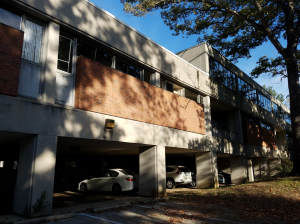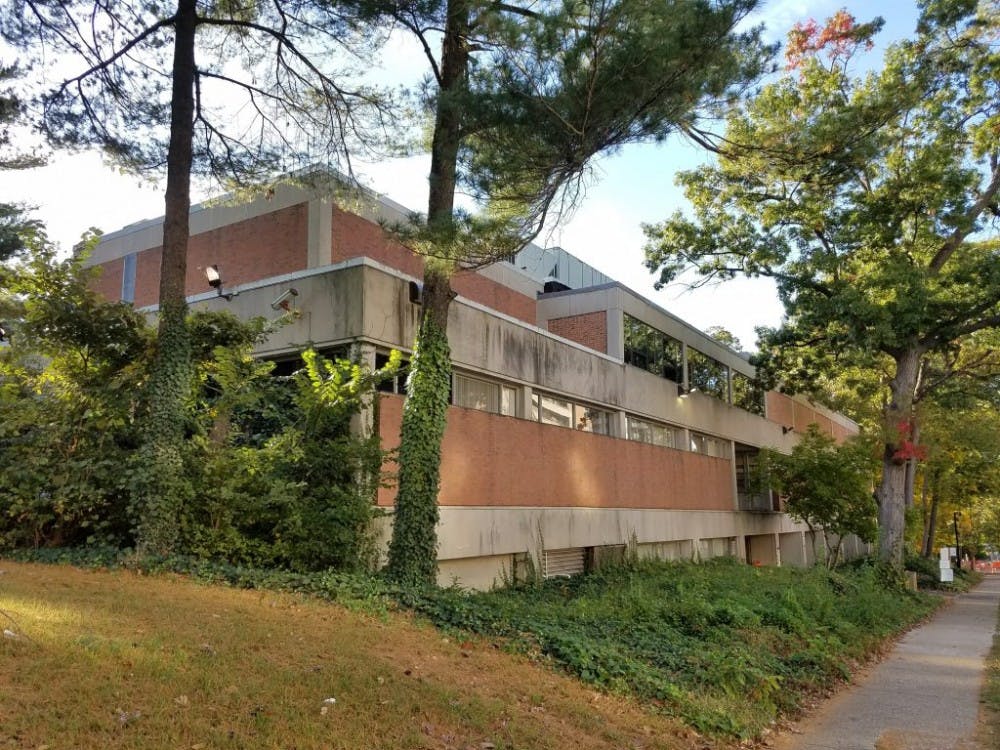Few students have heard of Old Carnegie, a derelict building on the northern fringe of campus. The University has decided to demolish it, most likely in the fiscal year 2018.
The building, as the home of the Carnegie Institution for Science’s Department of Embryology from 1960 to 2005, hosted scientists who made revolutionary discoveries, a number of which led to Nobel Prizes, before the Institution moved to a brand new building on San Martin Drive.
But since the 2005 handover, the University has let the building decay. Old Carnegie was repeatedly broken into: Windows were smashed and graffiti sprayed on the walls.
Missing Car Batteries and Barbed Wire
The Office of Recycling, led by Leana Houser, now uses part of the building as a storage space for its extra waste, recycling and compost bins.

After a series of break-ins, the Johns Hopkins Office of Facilities & Real Estate (JHFRE) and Houser locked off most of the building, boarded up the broken windows and placed fencing topped with barbed wire throughout the area that the Office of Recycling uses.
Jessica Billeter and Andy Ingersoll, two seniors who work for the Office of Recycling, often go in and out of Old Carnegie. The building currently has no water connection, and the electricity often goes out, leaving Billeter and Ingersoll to move bins in the dark.
Even with the increased security presence in recent years, multiple car batteries used to power the compactors outside the building have been stolen in recent months, leaving the recycling crew stuck.
“When somebody takes the battery, you can’t empty the paper into the compactor,” Billeter said.
They say that the security changes that Houser and JHFRE implemented make Old Carnegie a relatively safe place to work.
“Knowing that it’s all blocked off and you can see the barbed wire and the locks on the inside, I feel pretty safe,” Ingersoll said. “The part we go into — you wouldn’t know it was derelict.”
But Billeter sometimes feels uncomfortable in the building.
“I feel a little bit nervous working in it because it’s an old building. There are sometimes noises, and I’m like ‘Oh, what’s that noise,’ but I feel pretty safe. We have a lock outside the door,” Billeter said. “I make sure I bring my phone and the walkie-talkie just in case I were to get trapped in the building.”
Houser understands Billeter’s concern and agreed that the building is creepy.
“When I go in there, I’m freaked out because it reminds me almost of when an alarm goes off, when there’s a leak or a bomb — like something happened and people just left,” Houser said. “It looks like people just abandoned it, and then it’s also creepy because there is a lot of graffiti and you can tell people hung out there — messages like ‘They’ll find you’ or ‘They’re going to come get you.’”
However, with security keeping a closer eye on the building and the parking lot still in use underneath the structure, Houser feels more comfortable with letting her student employees into the building.
“I was having some concerns about safety going in, so we did full-on asbestos testing and everything came out clean... And we fenced all the parts of the space that we use, and we put locks on any external doorways,” Houser said “Once we got all that up, I felt much, much better about letting people go in there.”
Houser agrees that the space is functional, yet far from her headquarters in Building 3 behind the Wyman Park Building. She can’t keep as close of an eye on her bins and on deliveries as she would like.
“It actually might be better for us if we had another space closer. We’re generally on campus doing everything, and Old Carnegie is at the edge of campus and it’s far from here too,” Houser said. “Whatever the University decides is best, we will work with it. Hopefully we’ll have a voice. I’m in Facilities, so I think we’ll have a voice.”
The Office of Recycling got the space at Old Carnegie after JHFRE realized that the building would be the ideal place to store equipment from the University’s expanding recycling operations.
“It was a great location for us because it was off-site, out of mind, so we moved a lot of the recycling operation up there and took advantage of some of the open space in the building,” Ashwood said.
The Building’s Nobel History
Before the boarded up windows and graffiti, Old Carnegie was the site of cutting-edge genetics research.
Allan Spradling, former director of the Carnegie Institution’s Department of Embryology and a renowned molecular biologist, spent decades at Old Carnegie, where he made his most significant developmental biology discoveries using the drosophila fruit fly genus.
Spradling highlighted the many revolutionary scientific moments made at Old Carnegie, including the first time a gene was purified and the discovery of transposons.
“They figured out how to use centrifuges and cesium gradients to separate certain genes from DNA that are actually a different density from the bulk of the DNA,” he said. “The first animal genes ever cloned were cloned in that building.”
Andrew Fire, now a professor at Stanford, won the Nobel Prize in Physiology and Medicine for discovery of RNA interference (RNAi) in Old Carnegie, which has spawned an entire outpouring of research on gene editing.
Spradling recalled how the Institution adapted the building to suit the needs of ever-evolving research, including the unconventional way the scientists made room for storing mice and zebrafish for experiments by constantly adapting old rooms for new uses.
However, Spradling added that for Hopkins, leaving a marginally useful, old building vacant made sense from a financial perspective. And besides, he loves the Institution’s new, state-of-the-art building.
“They needed to do something with it sooner. When we handed it over to them, that was a building that had been in use every day with 100 people in there doing all kinds of experiments,” he said. “They could have put a function into that building. You have to understand how administrators think. They wanted to use it, they just didn’t have the money.”
While he has many fond memories of Old Carnegie, Spradling said that the discoveries made there and the relationships he had with his fellow scientists far outweigh the building’s historical significance.
“I’m just a little nostalgic. That’s where I looked at my first fruit fly and where that damn gene actually worked. That’s pretty exciting!” he said. “[But] you preserve it in the minds of the people and in the effects of what happened all across science. I think it’s memorialized in the completely different state of genetics. They are like works of art. They’re out there and people are listening to them. You don’t need the little room where Beethoven wrote the Fifth Symphony.”
Ingersoll echoed Spradling and rejected the notion that just because Nobel Prize discoveries were made in Old Carnegie, it justifies the building’s preservation.
“I feel like the importance is in the people and in the discovery itself rather than in the place,” Ingersoll said. “But I think it is sad that it isn’t more used because we use it as a warehouse and it used to be a pretty fancy building. It seems like with some renovation, it could be actually useful again.”
Billeter agreed, but questioned why the University let the building decay, even if it wasn’t in perfect shape.
“It surprises me because before the University acquired it, it was... pretty functional — so it wasn’t like run-down and that’s why the University decided to do nothing with it. So it makes me wonder why the University didn’t do something more with it,” she said. “At the very least they should use the parking garage attached to it.”
But Houser recognizes that the University has limited resources to redevelop old buildings with limited functionality.
“We have a lot of buildings on campus [that] need to be renovated, so the occupants will leave and then [JHFRE] renovate them, and sometimes there’s a little bit of a gap between the occupants leaving and any renovations actually taking place, when they don’t have money,” Houser said.
This year, JHFRE decided Old Carnegie’s fate, and the building will be demolished.
“It was the next project in line. We wanted to do it some point soon, and it was time to do it,” Ashwood said. “I don’t think there was any other reason than that.”





